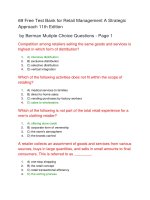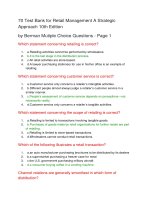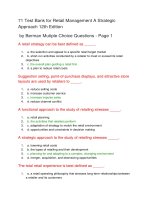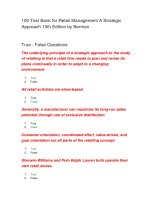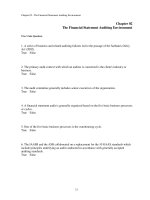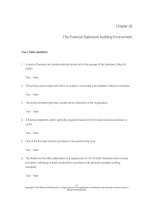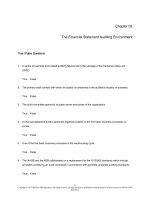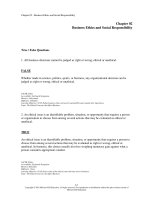Canadian human resource management a strategic approach 10th edition schwind test bank
Bạn đang xem bản rút gọn của tài liệu. Xem và tải ngay bản đầy đủ của tài liệu tại đây (430.06 KB, 37 trang )
02
Student: ___________________________________________________________________________
1.
For any human resource department to be effective, it must first have a clear understanding of
A. the jobs found throughout the organization
B. the size of the organization
C. the customer base
D. the technology involved
E. the legal environment the firm operates within
2.
The definition of a job is
A. a position held by one person
B. whatever work is assigned on a particular day
C. the physical work space occupied
D. a group of related activities and duties
E. the same as instructions given by the immediate manager
3.
The definition of a job is such that a job may be held by
A. no more than one person
B. one or more people so long as they are in different departments
C. one or more people so long as they are in the same department
D. any number of people regardless of location
E. part-time employees only
4.
The collection of tasks and responsibilities performed by one person is called a
A. job
B. position
C. duty
D. chore
E. job summary
5.
A business has one supervisor and six workers; the workers have identical tasks and responsibilities.
Therefore there exists
A. seven jobs
B. six jobs and one position
C. two jobs and seven positions
D. seven jobs and two positions
E. seven jobs and one position
6.
Major human resource activities that rely on job analysis information include all the following except
A. determination of training needs
B. job design/redesign
C. fair compensation policies
D. setting of realistic performance standards
E. maintenance of the organization's physical infrastructure
7.
Job analysis allows human resource specialists to
A. determine proper colour schemes for various departments
B. justify their existence
C. help protect the organization from charges of discrimination
D. avoid detailed job descriptions
E. avoid legal requirements
8.
There are __________ phases in the job analysis process.
A. 2
B. 3
C. 4
D. 5
E. 6
9.
Phase 1 of the job analysis process includes all the following except
A. preparation for job analysis
B. collection of job analysis information
C. uses of job analysis information
D. familiarization with the organization and jobs
E. identification of jobs to be analyzed
10. In the first phase of job analysis, one activity a human resource specialist must do is
A. become familiar with the organization and its jobs
B. determine sources of information
C. design collection methods
D. collect job analysis information
E. design job descriptions
11. Job analysis information is used for all the following except
A. writing job descriptions
B. determining profit margins
C. designing performance standards
D. job design
E. assessing job specifications
12. In identifying jobs to be analyzed, likely targets often include the following, except
A. jobs that are crucial to organizational success
B. jobs that may preclude members of equity target groups
C. jobs that are difficult to learn or perform
D. jobs where there is continuous hiring
E. jobs involving computers
13. The Vancouver Fire Department was found to be in violation of the Human Rights Act by having a
minimum height requirement for applicants. This could likely have been avoided by
A. simply re-writing the job description
B. avoiding taking the matter to the Human Rights Commission
C. a proper job analysis process
D. appealing to city officials
E. keeping the requirements secret
14. The collection phase of job analysis includes
A. determination of the uses of job analysis information
B. identification of jobs to be analyzed
C. determination of the source(s) of job data
D. familiarization with organizational mission
E. design of job descriptions and specifications
15. Using existing job descriptions and specifications as the source of data for a job analysis is an example of
which type of source of job data?
A. human
B. non-human
C. traditional
D. specific
E. dynamic
16. Human sources of organizational job data could include all the following except
A. managers at other similar businesses
B. job incumbents
C. supervisors
D. customers
E. subordinates
17. Non-human sources of job analysis data could include all the following except
A. existing job descriptions
B. safety manuals
C. internet research
D. equipment design blueprints
E. interviews with employees and supervisors
18. Most job analysis checklists will attempt to measure all of the following items except
A. duties and responsibilities
B. total wages or salary received
C. performance standards
D. working conditions
E. safety hazards
19. Standardized questionnaires to collect job information measure the following
A. compensation levels
B. workstation design
C. absenteeism
D. performance-related information
E. previous job incumbents
20. The technique where incumbents provide examples of behaviours required to do a job effectively, and the
way to do it is considered a(n)
A. Functional Job Analysis
B. Occupational Information Network
C. Position Analysis Questionnaire
D. Critical Incident Method
E. Fleishman's Job Analysis System
21. Which job analysis method focuses on cognitive, psychomotor, physical, and sensory abilities and is
relatively new?
A. Functional Job Analysis
B. Occupational Information Network
C. Position Analysis Questionnaire
D. Critical Incident Method
E. Fleishman's Job Analysis System
22. Which job analysis method asks reviewers to determine the degree to which 194 different task elements
are present in a specific job?
A. Functional Job Analysis
B. Occupational Information Network
C. Position Analysis Questionnaire
D. Critical Incident Method
E. Fleishman's Job Analysis System
23. In choosing a data collection method for job analysis information, the best way is
A. interviewing
B. observation
C. (mailed) questionnaire
D. employee log
E. there is no one best way
24. Interviews are an effective way to collect job information for all of the following reasons except
A. interviewers can explain unclear questions
B. they are quick and cost effective
C. answers can be clarified
D. job holders and supervisors provide input
E. the process can provide accuracy
25. Generally speaking, the use of employee logs as a collection method for job analysis information would
likely be most useful when the goal is to look at
A. job selection procedures
B. training procedures
C. specific tasks and activities
D. compensation policies
E. discipline policies
26. When knowledge about jobs and their requirements are collected by a human resource department, it is
called
A. job previewing
B. job analysis
C. job detail
D. job research
E. job standards setting
27. The key parts of a job description have sections which include
A. human characteristics, working conditions, performance standards, and tasks
B. job identity, reporting relationships, salary, and holidays
C. job responsibilities, job working conditions, performance standards, and compensation
D. job summary, reporting relationships, compensation, and tasks
E. job identity, job summary, job duties, and job working conditions
28. The job identity section on a job description would typically include the following except
A. job title
B. job summary
C. job location
D. job grade
E. job status
29. The two major job attributes that are used as classification criteria by the National Occupational
Classification (NOC) are
A. skill level and skill type
B. industry and occupational mobility
C. industry and skill type
D. education required and level of computerization
E. skill level and geographic location
30. The federal government created an occupational classification which uses the variables of skill level and
types of job. It is known as
A. DOT
B. NOC
C. www.workopolis.com
D. Position Analysis Questionnaire
E. Functional Job Analysis
31. A brief concise overview on a job description that tells what a job is, how it is done, and why, is called
the
A. job identity
B. job responsibilities and duties
C. job analysis
D. job summary
E. job design
32. The working conditions section on a job description could include all of the following except
A. hours of work
B. safety hazards
C. health hazards
D. travel requirements
E. salary range
33. One good means of checking the accuracy of job descriptions is to have them checked by
A. (selected) jobholders
B. the job supervisor(s)
C. an impartial committee from outside the job area
D. job holders and supervisors
E. other human resource specialists
34. A job specification describes
A. what a job does
B. where the job fits specifically within the organization
C. job demands and human characteristics required by them
D. specific job behaviours required by company policies
E. salary and benefits
35. A job specification is best illustrated by which of the following
A. "job reports to data entry supervisor"
B. "job requires adherence to specific company regulations"
C. "job requires lifting 20kg bags in wet, noisy environment"
D. "job deals solely with retail customers"
E. "job may involve shift work"
36. A competency is a skill or ability associated with high
A. salary
B. job performance
C. job design
D. job description
E. job analysis
37. A competency model used in job design, can be developed for all of the following except
A. teams
B. work units
C. specific jobs
D. key skills and abilities
E. individuals
38. Designing proper job performance standards is another application of
A. job analysis
B. job summary
C. job identity
D. job location
E. job specification
39. Proper job performance standards can do all the following, with the likely exception of
A. challenging and motivating employees
B. maintaining high performance levels
C. allowing managers to monitor and controlling work performance
D. reducing morale
E. contributing to employee satisfaction
40. Without measurable job performance standards
A. performance standards are relatively worthless
B. management is more effective
C. performance will remain at a constant high level
D. morale will increase among the best workers
E. workers can be in a strike position
41. When actual performance strays from the performance standards for a job, one likely corrective action
may be
A. changes to the standards
B. having another person measure performance
C. dismissal
D. changing the job title
E. changing jobs from full-time to part-time
42. Job performance standards may be obtained from all the following except
A. job analysis information
B. work measurement
C. benchmarking
D. external applicant pool
E. industry standards
43. Competencies are used for all of the following except
A. performance management
B. compensation
C. exit interviews
D. career development
E. training
44. Internal job analysis information can produce valid job performance standards under all the below
conditions except
A. when performance is quantified
B. when tasks are complex and specialized
C. when performance is easily measured
D. when performance standards are understood by workers and supervisors
E. when performance requires little interpretation
45. When job analysts focus on developing broader skills rather than performing specific duties they are
using a
A. reactive system
B. competency matrix
C. job redesign portfolio
D. structured systematic appraisal
E. total organization systems approach
46. In the last fifty years many jobs have been redesigned, often due to
A. global competition
B. global competition and complex technology
C. increasing worker expectations
D. global competition, complex technology, and increasing worker expectations
E. increasing worker expectations and global competition
47. All of the below are key job design considerations except
A. ergonomic
B. employee
C. financial
D. environmental
E. organizational
48. Organizational considerations of job design include
A. efficiency and work flow
B. task variety
C. feedback
D. task identity
E. task significance
49. One of the organizational considerations involved in job design is
A. variety
B. work flow
C. task significance
D. feedback
E. task identity
50. Efficiency is a(n)
A. organizational consideration of job design
B. ergonomic consideration of job design
C. employee consideration of job design
D. environmental (societal) consideration of job design
E. considered the same as task identity for job analysis purposes
51. The physical relationship between the worker and the work is a(n)
A. organizational consideration of job design
B. ergonomic consideration of job design
C. employee consideration of job design
D. environmental consideration of job design
E. functional consideration of job design
52. Among the key employee considerations in job design are all the following except
A. task efficiency
B. autonomy
C. task identity
D. variety
E. task significance
53. Employee considerations of job design do not include
A. work flow
B. task significance
C. autonomy
D. variety
E. feedback
54. Jobs that give workers autonomy tend to increase an employee's
A. self esteem and job performance
B. salary and vacation allotment
C. seniority level and self esteem
D. productivity and apathy
E. dissatisfaction and complaints
55. Task identity is
A. an ergonomic consideration of job design
B. an organizational consideration of job design
C. an employee consideration of job design
D. an environmental consideration of job design
E. both an ergonomic and an environmental consideration of job design
56. To increase the quality of work life in specialized jobs, HR departments will implement
A. job rotation, job enlargement, or job enrichment programs
B. job enlargement, autonomy, and job rotation programs
C. feedback, variety, and task identity
D. ergonomic studies, job rotation, and work teams
E. job enrichment, work teams, and employee suggestions programs
57. Task significance is a(n)
A. organizational consideration of job design
B. ergonomic consideration of job design
C. employee consideration of job design
D. environmental consideration of job design
E. legal consideration of job design
58. Job rotation is a(n)
A. organizational consideration of job design
B. environmental consideration of job design
C. employee consideration of job design
D. ergonomic consideration of job design
E. financial consideration of job design
59. Moving employees between different jobs is called
A. job enrichment
B. job enlargement
C. job design
D. job rotation
E. team building
60. When jobs are expanded by increasing the number of related tasks an employee does, it is an example
of
A. job rotation
B. job enrichment
C. job analysis
D. job specifications
E. job enlargement
61. When job design increases a worker's responsibility and control over a job, this is an example of
A. job enlargement
B. job enrichment
C. team work
D. job analysis
E. job performance standards
62. Environmental considerations of job design include
A. job enrichment
B. social expectations
C. work flow
D. feedback
E. ergonomic controls
63. Work practices are an
A. employee consideration of job design
B. ergonomic consideration of job design
C. organizational consideration of job design
D. environmental consideration of job design
E. legal consideration of job design
64. The text suggests that accurate and timely job descriptions are becoming increasingly difficult to produce
for a variety of reasons including all the following except
A. global competition
B. changing worker profile
C. fast technological obsolescence
D. rapid increase in knowledge requirements
E. lack of task identity, variety, and significance
65. Generally, job design is among one of the least important factors in organizational productivity.
True False
66. A job usually consist of grouping unrelated tasks.
True False
67. If more than one person holds a particular job it is called a position.
True False
68. Job analysis is important for such human resource activities as determining job requirements, training
needs, and compensation policies.
True False
69. Job redesign is a major organizational activity that relies on job analysis information.
True False
70. Identification of realistic and challenging performance standards is one of the few human resource
activities that does not rely on job analysis information.
True False
71. Job analysis has five major consecutive phases: preparation, collection of data, employee selection,
employee orientation, and use of collected data.
True False
72. One key activity in phase 1 of the job analysis process is familiarization with the organization's structure,
strategy, and desired outcomes.
True False
73. Identification of jobs to be analyzed is the third key activity of phase 1 of job analysis.
True False
74. Likely targets of job analysis could be jobs that continuously hire, jobs that are difficult, or jobs that are
critical to the organization.
True False
75. One target of job analysis should be jobs that appear to preclude certain classes of people, such as women
or visible minorities.
True False
76. The use of inappropriate job requirements causes organizations to break criminal laws.
True False
77. Phase 2 of the job analysis process is the collection of all relevant information.
True False
78. Phase 2 of the job analysis process contains three interrelated activities.
True False
79. Two of the key activities in phase 2 of the job analysis process are: determination of job data sources and
choice of method for data collection.
True False
80. Two of the key activities in phase 2 of the job analysis process are: identification of jobs to be analyzed
and data collection instrument design.
True False
81. Obtaining job data can include only one human and non-human source.
True False
82. The basic source of information about a job is the job incumbent.
True False
83. Using the same questionnaire on similar jobs tends to produce less useful job analysis data.
True False
84. Using the same questionnaire across similar jobs prevents analysts from obtaining information that
reflects the differences between the jobs.
True False
85. Most job analysis questionnaires attempt to measure, among other things, duties, working conditions, and
performance standards.
True False
86. Most job analysis questionnaires attempt to measure a variety of job characteristics but do not attempt to
measure current job performance standards.
True False
87. The human characteristics required by the job holder is a key piece of information measured by job
analysts.
True False
88. The Functional Job Analysis and the Position Analysis Questionnaire are two of the most popular job
analysis tools.
True False
89. Job analysis data collection methods can include interviews, questionnaires, and observation.
True False
90. The best method to collect job analysis information is by utilizing the Critical Incident Method
(CIM).
True False
91. Employee logs are often seen as a nuisance by managers and employees.
True False
92. Observation as a job analysis data collection tool tends to be the consistently most accurate means of
information gathering.
True False
93. As a means of collecting job analysis information, employee logs are popular with both managers and
workers, are quick and inexpensive to do, and maintain a high level of accuracy over time.
True False
94. Uses of job analysis information include job descriptions, job specifications, and job performance
standards.
True False
95. Job identity, job summary, and job duties are all parts of a job description.
True False
96. Job descriptions are also known as job summaries.
True False
97. Actual working conditions are not a part of a job description.
True False
98. A job description defines what a job does; a job specification describes what the job demands on
employees are.
True False
99. There is no such thing as a needless job specification as all job requirements service a valid purpose.
True False
100.Challenging employees to "do a good job" is an example of setting an effective performance
standard.
True False
101.Effective job performance standards can contribute directly to employee satisfaction.
True False
102.Job standards can be set from job analysis information when job features include performance that is
quantified and that is easily measurable.
True False
103.Competency-based job descriptions are designed to identify characteristics that are associated with
superior job performance.
True False
104.When identifying job required competencies, job analysts include skills and knowledge, but not
behaviours.
True False
105.A competency model lists the competencies required in a particular job.
True False
106.Job design is one use of job analysis information, but job redesign is not.
True False
107.Proper job design can result in increased commitment, motivation, satisfaction, and performance on
behalf of employees.
True False
108.Organizational, ergonomic, environmental, and employee considerations are all critical elements in
designing jobs.
True False
109.Efficiency, workflow, and ergonomics are all organizational considerations of job design.
True False
110.Ergonomic considerations are important to not only job design but also safety in the workplace.
True False
111.Jobs must be designed to help employees achieve better work-life balance.
True False
112.Employee considerations in job design include: ergonomics, autonomy, and job variety.
True False
113.The intent of involving employees in teams is to provide more autonomy, feedback, and
compensation.
True False
114.Environmental elements of job design include workforce availability and social expectations, but not
actual work practices.
True False
115.When HR departments conduct systematic studies of jobs to discover specifications and skill
requirements they are conducting _______________________.
________________________________________
116.A(n) __________ consists of a group of related activities and duties.
________________________________________
117.A(n) _____________ is a collection of tasks and responsibilities performed by an individual.
________________________________________
118.A position is different than a job in that it can only be held by _____________________.
________________________________________
119.Both large and small businesses can benefit from a proper __________ analysis.
________________________________________
120.The first step in the preparation for job analysis is a familiarization with the __________ and its jobs.
________________________________________
121.Determination of jobs to be analyzed is a key activity in the (name) __________ phase of job
analysis.
________________________________________
122.Inappropriate job requirements can lead to discrimination and violations of the
___________________.
________________________________________
123.Phase 2 of job analysis involves the __________ of job analysis information.
________________________________________
124.When determining from where to collect job data, both human and __________ sources can be
considered.
________________________________________
125.Job analysis data collection questionnaires are sometimes called __________ that seek to collect
information about jobs in a uniform matter.
________________________________________
126.Job analysts use similar questionnaires for similar jobs because they want answers to reflect differences in
the __________ rather than differences in the __________ asked.
________________________________________
127.Job analysis seeks information about job standards, which are used to evaluate __________
standards.
________________________________________
128.Functional Job Analysis and Positional Analysis Questionnaire are two standardized forms currently
available for __________.
________________________________________
129.One means of collecting job analysis data that is relatively unpopular, tends to be inaccurate, and is costly
is the ____________________.
________________________________________
130.Job analysis information is used to develop job descriptions, job specifications, and job performance
__________.
________________________________________
131.The document that describes the duties, reporting structure, and working conditions of a specific job is
called a(n) ______________________.
________________________________________
132.A well-developed ____________________ helps an organization define clearly the required duties and
responsibilities associated with a position.
________________________________________
133.In a job description, hours of work, travel requirements, and safety and health hazards are referred to in
the __________________________ section.
________________________________________
134.While a job description defines what a job does, a ___________________ describes what a job demands
of employees.
________________________________________
135._______________________ are both objectives for employee efforts, and criteria against which job
success is measured.
________________________________________
136.A(n) __________ is a knowledge, skill, ability, or characteristic associated with superior job
performance.
________________________________________
137.___________________ can be only identified after careful analysis of the work of high performing
employees.
________________________________________
138.Productivity and quality of work life is tied to job __________.
________________________________________
139.The four critical elements of job design are employee, organizational, __________, and ergonomic
considerations.
________________________________________
140.Work flow is one of the __________ considerations of work design.
________________________________________
141.__________ considerations deal with the physical relationship between workers and their work.
________________________________________
142.When an employee feels responsible for what they do in their job, they have achieved a level of
____________.
________________________________________
143.When workers feel little pride in the results of their job or have little sense of responsibility for an entire
piece of work, they are likely in jobs that lack any ___________________.
________________________________________
144.As workers become more __________ and affluent, routine jobs that are very __________, such as
assembly-line positions, hold less and less appeal for many people.
________________________________________
145.While job _____________ adds planning and control responsibilities, job __________ adds more
tasks.
________________________________________
146._____________________ are categories of jobs that are closely related by similar duties, responsibilities,
skills, or job elements.
________________________________________
147.Environmental elements when considering job design include workforce availability, work practices, and
_________________________.
________________________________________
148.What purpose does job analysis information serve for human resource departments?
149.Describe the various methods of collecting job analysis information. What are the strengths and
weaknesses of each method?
150.Describe each of the key components of a job description.
151.What is the purpose of job descriptions, job specifications, and job performance standards?
152.Competency based job descriptions can be used for many purposes within an organization. Discuss their
uses.
153.Consider the job of a university professor.
What methods will you use to collect information on the job?
What are the key dimensions of performance that such a study will produce?
154.Identify the different the different consideration in job design and briefly explain each.
155.Explain the three techniques for categorizing similar jobs into families.
156.Discuss the major challenges affecting job design.
157.What problems might arise in a company that designed jobs for the purpose of maximizing efficiency
without thoroughly considering individual employee needs?
158.What are the advantages and disadvantages of highly specialized jobs?
02 Key
1.
(p. 51)
For any human resource department to be effective, it must first have a clear understanding of
A. the jobs found throughout the organization
B. the size of the organization
C. the customer base
D. the technology involved
E. the legal environment the firm operates within
Difficulty: Medium
Learning Objective: 02-01 Describe the uses of job analysis information for human resource managers.
Schwind - Chapter 02 #1
2.
(p. 51)
The definition of a job is
A. a position held by one person
B. whatever work is assigned on a particular day
C. the physical work space occupied
D. a group of related activities and duties
E. the same as instructions given by the immediate manager
Difficulty: Medium
Learning Objective: 02-01 Describe the uses of job analysis information for human resource managers.
Schwind - Chapter 02 #2
3.
(p. 51)
The definition of a job is such that a job may be held by
A. no more than one person
B. one or more people so long as they are in different departments
C. one or more people so long as they are in the same department
D. any number of people regardless of location
E. part-time employees only
Difficulty: Easy
Learning Objective: 02-01 Describe the uses of job analysis information for human resource managers.
Schwind - Chapter 02 #3
4.
(p. 51)
The collection of tasks and responsibilities performed by one person is called a
A. job
B. position
C. duty
D. chore
E. job summary
Difficulty: Medium
Learning Objective: 02-01 Describe the uses of job analysis information for human resource managers.
Schwind - Chapter 02 #4
5.
(p. 51)
A business has one supervisor and six workers; the workers have identical tasks and responsibilities.
Therefore there exists
A. seven jobs
B. six jobs and one position
C. two jobs and seven positions
D. seven jobs and two positions
E. seven jobs and one position
Difficulty: Medium
Learning Objective: 02-01 Describe the uses of job analysis information for human resource managers.
Schwind - Chapter 02 #5
6.
(p. 52,
Fig 2-1)
Major human resource activities that rely on job analysis information include all the following
except
A. determination of training needs
B. job design/redesign
C. fair compensation policies
D. setting of realistic performance standards
E. maintenance of the organization's physical infrastructure
Difficulty: Medium
Learning Objective: 02-01 Describe the uses of job analysis information for human resource managers.
Schwind - Chapter 02 #6
7.
(p. 52,
Fig 2-1)
Job analysis allows human resource specialists to
A. determine proper colour schemes for various departments
B. justify their existence
C. help protect the organization from charges of discrimination
D. avoid detailed job descriptions
E. avoid legal requirements
Difficulty: Medium
Learning Objective: 02-01 Describe the uses of job analysis information for human resource managers.
Schwind - Chapter 02 #7
8.
(p. 52)
There are __________ phases in the job analysis process.
A. 2
B. 3
C. 4
D. 5
E. 6
Difficulty: Medium
Learning Objective: 02-02 Discuss the various steps in conducting job analysis and methods of job data collection.
Schwind - Chapter 02 #8
9.
(p. 52-53)
Phase 1 of the job analysis process includes all the following except
A. preparation for job analysis
B. collection of job analysis information
C. uses of job analysis information
D. familiarization with the organization and jobs
E. identification of jobs to be analyzed
Difficulty: Hard
Learning Objective: 02-02 Discuss the various steps in conducting job analysis and methods of job data collection.
Schwind - Chapter 02 #9
10.
(p. 51-52)
In the first phase of job analysis, one activity a human resource specialist must do is
A. become familiar with the organization and its jobs
B. determine sources of information
C. design collection methods
D. collect job analysis information
E. design job descriptions
Difficulty: Medium
Learning Objective: 02-02 Discuss the various steps in conducting job analysis and methods of job data collection.
Schwind - Chapter 02 #10
11.
(p. 52,
Fig 5-2)
Job analysis information is used for all the following except
A. writing job descriptions
B. determining profit margins
C. designing performance standards
D. job design
E. assessing job specifications
Difficulty: Easy
Learning Objective: 02-02 Discuss the various steps in conducting job analysis and methods of job data collection.
Schwind - Chapter 02 #11
12.
(p. 53)
In identifying jobs to be analyzed, likely targets often include the following, except
A. jobs that are crucial to organizational success
B. jobs that may preclude members of equity target groups
C. jobs that are difficult to learn or perform
D. jobs where there is continuous hiring
E. jobs involving computers
Difficulty: Medium
Learning Objective: 02-02 Discuss the various steps in conducting job analysis and methods of job data collection.
Schwind - Chapter 02 #12
13.
(p. 53-54)
The Vancouver Fire Department was found to be in violation of the Human Rights Act by having a
minimum height requirement for applicants. This could likely have been avoided by
A. simply re-writing the job description
B. avoiding taking the matter to the Human Rights Commission
C. a proper job analysis process
D. appealing to city officials
E. keeping the requirements secret
Difficulty: Medium
Learning Objective: 02-02 Discuss the various steps in conducting job analysis and methods of job data collection.
Schwind - Chapter 02 #13
14.
(p. 54)
The collection phase of job analysis includes
A. determination of the uses of job analysis information
B. identification of jobs to be analyzed
C. determination of the source(s) of job data
D. familiarization with organizational mission
E. design of job descriptions and specifications
Difficulty: Hard
Learning Objective: 02-02 Discuss the various steps in conducting job analysis and methods of job data collection.
Schwind - Chapter 02 #14
15.
(p. 54,
Fig 2-3)
Using existing job descriptions and specifications as the source of data for a job analysis is an example
of which type of source of job data?
A. human
B. non-human
C. traditional
D. specific
E. dynamic
Difficulty: Hard
Learning Objective: 02-02 Discuss the various steps in conducting job analysis and methods of job data collection.
Schwind - Chapter 02 #15
16.
(p. 54,
Fig 2-3)
Human sources of organizational job data could include all the following except
A. managers at other similar businesses
B. job incumbents
C. supervisors
D. customers
E. subordinates
Difficulty: Medium
Learning Objective: 02-02 Discuss the various steps in conducting job analysis and methods of job data collection.
Schwind - Chapter 02 #16
17.
Non-human sources of job analysis data could include all the following except
existing job descriptions
B. safety manuals
C. internet research
D. equipment design blueprints
E. interviews with employees and supervisors
(p. 54, 2-3) A.
Difficulty: Medium
Learning Objective: 02-02 Discuss the various steps in conducting job analysis and methods of job data collection.
Schwind - Chapter 02 #17
18.
(p. 55-56)
Most job analysis checklists will attempt to measure all of the following items except
A. duties and responsibilities
B. total wages or salary received
C. performance standards
D. working conditions
E. safety hazards
Difficulty: Medium
Learning Objective: 02-02 Discuss the various steps in conducting job analysis and methods of job data collection.
Schwind - Chapter 02 #18
19.
(p. 59)
Standardized questionnaires to collect job information measure the following
A. compensation levels
B. workstation design
C. absenteeism
D. performance-related information
E. previous job incumbents
Difficulty: Medium
Learning Objective: 02-02 Discuss the various steps in conducting job analysis and methods of job data collection.
Schwind - Chapter 02 #19
20.
(p. 56)
The technique where incumbents provide examples of behaviours required to do a job effectively, and
the way to do it is considered a(n)
A. Functional Job Analysis
B. Occupational Information Network
C. Position Analysis Questionnaire
D. Critical Incident Method
E. Fleishman's Job Analysis System
Difficulty: Medium
Learning Objective: 02-02 Discuss the various steps in conducting job analysis and methods of job data collection.
Schwind - Chapter 02 #20
21.
(p. 56)
Which job analysis method focuses on cognitive, psychomotor, physical, and sensory abilities and is
relatively new?
A. Functional Job Analysis
B. Occupational Information Network
C. Position Analysis Questionnaire
D. Critical Incident Method
E. Fleishman's Job Analysis System
Difficulty: Medium
Learning Objective: 02-02 Discuss the various steps in conducting job analysis and methods of job data collection.
Schwind - Chapter 02 #21
22.
(p. 56)
Which job analysis method asks reviewers to determine the degree to which 194 different task
elements are present in a specific job?
A. Functional Job Analysis
B. Occupational Information Network
C. Position Analysis Questionnaire
D. Critical Incident Method
E. Fleishman's Job Analysis System
Difficulty: Medium
Learning Objective: 02-02 Discuss the various steps in conducting job analysis and methods of job data collection.
Schwind - Chapter 02 #22
23.
(p. 58)
In choosing a data collection method for job analysis information, the best way is
A. interviewing
B. observation
C. (mailed) questionnaire
D. employee log
E. there is no one best way
Difficulty: Medium
Learning Objective: 02-02 Discuss the various steps in conducting job analysis and methods of job data collection.
Schwind - Chapter 02 #23
24.
(p. 58-59)
Interviews are an effective way to collect job information for all of the following reasons except
A. interviewers can explain unclear questions
B. they are quick and cost effective
C. answers can be clarified
D. job holders and supervisors provide input
E. the process can provide accuracy
Difficulty: Medium
Learning Objective: 02-02 Discuss the various steps in conducting job analysis and methods of job data collection.
Schwind - Chapter 02 #24
25.
(p. 59)
Generally speaking, the use of employee logs as a collection method for job analysis information
would likely be most useful when the goal is to look at
A. job selection procedures
B. training procedures
C. specific tasks and activities
D. compensation policies
E. discipline policies
Difficulty: Medium
Learning Objective: 02-02 Discuss the various steps in conducting job analysis and methods of job data collection.
Schwind - Chapter 02 #25
26.
(p. 60)
When knowledge about jobs and their requirements are collected by a human resource department, it
is called
A. job previewing
B. job analysis
C. job detail
D. job research
E. job standards setting
Difficulty: Easy
Learning Objective: 02-02 Discuss the various steps in conducting job analysis and methods of job data collection.
Schwind - Chapter 02 #26
27.
(p. 61)
The key parts of a job description have sections which include
A. human characteristics, working conditions, performance standards, and tasks
B. job identity, reporting relationships, salary, and holidays
C. job responsibilities, job working conditions, performance standards, and compensation
D. job summary, reporting relationships, compensation, and tasks
E. job identity, job summary, job duties, and job working conditions
Difficulty: Medium
Learning Objective: 02-03 Describe the contents of a job description and a job specification.
Schwind - Chapter 02 #27
28.
(p. 61)
The job identity section on a job description would typically include the following except
A. job title
B. job summary
C. job location
D. job grade
E. job status
Difficulty: Medium
Learning Objective: 02-03 Describe the contents of a job description and a job specification.
Schwind - Chapter 02 #28
29.
(p. 61)
The two major job attributes that are used as classification criteria by the National Occupational
Classification (NOC) are
A. skill level and skill type
B. industry and occupational mobility
C. industry and skill type
D. education required and level of computerization
E. skill level and geographic location
Difficulty: Medium
Learning Objective: 02-03 Describe the contents of a job description and a job specification.
Schwind - Chapter 02 #29
30.
(p. 61)
The federal government created an occupational classification which uses the variables of skill level
and types of job. It is known as
A. DOT
B. NOC
C. www.workopolis.com
D. Position Analysis Questionnaire
E. Functional Job Analysis
Difficulty: Medium
Learning Objective: 02-03 Describe the contents of a job description and a job specification.
Schwind - Chapter 02 #30
31.
(p. 62)
A brief concise overview on a job description that tells what a job is, how it is done, and why, is called
the
A. job identity
B. job responsibilities and duties
C. job analysis
D. job summary
E. job design
Difficulty: Medium
Learning Objective: 02-03 Describe the contents of a job description and a job specification.
Schwind - Chapter 02 #31
32.
(p. 62)
The working conditions section on a job description could include all of the following except
A. hours of work
B. safety hazards
C. health hazards
D. travel requirements
E. salary range
Difficulty: Easy
Learning Objective: 02-03 Describe the contents of a job description and a job specification.
Schwind - Chapter 02 #32
33.
(p. 63)
One good means of checking the accuracy of job descriptions is to have them checked by
A. (selected) jobholders
B. the job supervisor(s)
C. an impartial committee from outside the job area
D. job holders and supervisors
E. other human resource specialists
Difficulty: Medium
Learning Objective: 02-03 Describe the contents of a job description and a job specification.
Schwind - Chapter 02 #33
34.
(p. 64)
A job specification describes
A. what a job does
B. where the job fits specifically within the organization
C. job demands and human characteristics required by them
D. specific job behaviours required by company policies
E. salary and benefits
Difficulty: Medium
Learning Objective: 02-03 Describe the contents of a job description and a job specification.
Schwind - Chapter 02 #34
35.
(p. 64)
A job specification is best illustrated by which of the following
A. "job reports to data entry supervisor"
B. "job requires adherence to specific company regulations"
C. "job requires lifting 20kg bags in wet, noisy environment"
D. "job deals solely with retail customers"
E. "job may involve shift work"
Difficulty: Medium
Learning Objective: 02-03 Describe the contents of a job description and a job specification.
Schwind - Chapter 02 #35
36.
(p. 67)
A competency is a skill or ability associated with high
A. salary
B. job performance
C. job design
D. job description
E. job analysis
Difficulty: Easy
Learning Objective: 02-04 Discuss the various approaches to setting performance standards.
Schwind - Chapter 02 #36
37.
(p. 67)
A competency model used in job design, can be developed for all of the following except
A. teams
B. work units
C. specific jobs
D. key skills and abilities
E. individuals
Difficulty: Easy
Learning Objective: 02-04 Discuss the various approaches to setting performance standards.
Schwind - Chapter 02 #37
38.
(p. 68)
Designing proper job performance standards is another application of
A. job analysis
B. job summary
C. job identity
D. job location
E. job specification
Difficulty: Medium
Learning Objective: 02-04 Discuss the various approaches to setting performance standards.
Schwind - Chapter 02 #38
39.
(p. 65)
Proper job performance standards can do all the following, with the likely exception of
A. challenging and motivating employees
B. maintaining high performance levels
C. allowing managers to monitor and controlling work performance
D. reducing morale
E. contributing to employee satisfaction
Difficulty: Easy
Learning Objective: 02-04 Discuss the various approaches to setting performance standards.
Schwind - Chapter 02 #39
40.
(p. 65)
Without measurable job performance standards
A. performance standards are relatively worthless
B. management is more effective
C. performance will remain at a constant high level
D. morale will increase among the best workers
E. workers can be in a strike position
Difficulty: Easy
Learning Objective: 02-04 Discuss the various approaches to setting performance standards.
Schwind - Chapter 02 #40
41.
(p. 65)
When actual performance strays from the performance standards for a job, one likely corrective action
may be
A. changes to the standards
B. having another person measure performance
C. dismissal
D. changing the job title
E. changing jobs from full-time to part-time
Difficulty: Medium
Learning Objective: 02-04 Discuss the various approaches to setting performance standards.
Schwind - Chapter 02 #41
42.
(p. 66)
Job performance standards may be obtained from all the following except
A. job analysis information
B. work measurement
C. benchmarking
D. external applicant pool
E. industry standards
Difficulty: Medium
Learning Objective: 02-04 Discuss the various approaches to setting performance standards.
Schwind - Chapter 02 #42
43.
(p. 67)
Competencies are used for all of the following except
A. performance management
B. compensation
C. exit interviews
D. career development
E. training
Difficulty: Medium
Learning Objective: 02-04 Discuss the various approaches to setting performance standards.
Schwind - Chapter 02 #43
44.
(p. 66)
Internal job analysis information can produce valid job performance standards under all the below
conditions except
A. when performance is quantified
B. when tasks are complex and specialized
C. when performance is easily measured
D. when performance standards are understood by workers and supervisors
E. when performance requires little interpretation
Difficulty: Hard
Learning Objective: 02-04 Discuss the various approaches to setting performance standards.
Schwind - Chapter 02 #44
45.
(p. 67)
When job analysts focus on developing broader skills rather than performing specific duties they are
using a
A. reactive system
B. competency matrix
C. job redesign portfolio
D. structured systematic appraisal
E. total organization systems approach
Difficulty: Hard
Learning Objective: 02-04 Discuss the various approaches to setting performance standards.
Schwind - Chapter 02 #45
46.
(p. 68)
In the last fifty years many jobs have been redesigned, often due to
A. global competition
B. global competition and complex technology
C. increasing worker expectations
D. global competition, complex technology, and increasing worker expectations
E. increasing worker expectations and global competition
Difficulty: Easy
Learning Objective: 02-05 Outline the key considerations in job design.
Schwind - Chapter 02 #46
47.
(p. 69,
Fig 2-13)
All of the below are key job design considerations except
A. ergonomic
B. employee
C. financial
D. environmental
E. organizational
Difficulty: Medium
Learning Objective: 02-05 Outline the key considerations in job design.
Schwind - Chapter 02 #47
48.
(p. 69-70)
Organizational considerations of job design include
A. efficiency and work flow
B. task variety
C. feedback
D. task identity
E. task significance
Difficulty: Medium
Learning Objective: 02-05 Outline the key considerations in job design.
Schwind - Chapter 02 #48
49.
(p. 70)
One of the organizational considerations involved in job design is
A. variety
B. work flow
C. task significance
D. feedback
E. task identity
Difficulty: Medium
Learning Objective: 02-05 Outline the key considerations in job design.
Schwind - Chapter 02 #49
50.
(p. 69)
Efficiency is a(n)
A. organizational consideration of job design
B. ergonomic consideration of job design
C. employee consideration of job design
D. environmental (societal) consideration of job design
E. considered the same as task identity for job analysis purposes
Difficulty: Medium
Learning Objective: 02-05 Outline the key considerations in job design.
Schwind - Chapter 02 #50
51.
(p. 70)
The physical relationship between the worker and the work is a(n)
A. organizational consideration of job design
B. ergonomic consideration of job design
C. employee consideration of job design
D. environmental consideration of job design
E. functional consideration of job design
Difficulty: Hard
Learning Objective: 02-05 Outline the key considerations in job design.
Schwind - Chapter 02 #51
52.
(p. 71-72)
Among the key employee considerations in job design are all the following except
A. task efficiency
B. autonomy
C. task identity
D. variety
E. task significance
Difficulty: Easy
Learning Objective: 02-05 Outline the key considerations in job design.
Schwind - Chapter 02 #52
53.
(p. 71-72)
Employee considerations of job design do not include
A. work flow
B. task significance
C. autonomy
D. variety
E. feedback
Difficulty: Hard
Learning Objective: 02-05 Outline the key considerations in job design.
Schwind - Chapter 02 #53
54.
(p. 71)
Jobs that give workers autonomy tend to increase an employee's
A. self esteem and job performance
B. salary and vacation allotment
C. seniority level and self esteem
D. productivity and apathy
E. dissatisfaction and complaints
Difficulty: Medium
Learning Objective: 02-05 Outline the key considerations in job design.
Schwind - Chapter 02 #54
55.
(p. 72)
Task identity is
A. an ergonomic consideration of job design
B. an organizational consideration of job design
C. an employee consideration of job design
D. an environmental consideration of job design
E. both an ergonomic and an environmental consideration of job design
Difficulty: Medium
Learning Objective: 02-05 Outline the key considerations in job design.
Schwind - Chapter 02 #55
56.
(p. 72-73)
To increase the quality of work life in specialized jobs, HR departments will implement
A. job rotation, job enlargement, or job enrichment programs
B. job enlargement, autonomy, and job rotation programs
C. feedback, variety, and task identity
D. ergonomic studies, job rotation, and work teams
E. job enrichment, work teams, and employee suggestions programs
Difficulty: Medium
Learning Objective: 02-05 Outline the key considerations in job design.
Schwind - Chapter 02 #56
57.
(p. 72)
Task significance is a(n)
A. organizational consideration of job design
B. ergonomic consideration of job design
C. employee consideration of job design
D. environmental consideration of job design
E. legal consideration of job design
Difficulty: Medium
Learning Objective: 02-05 Outline the key considerations in job design.
Schwind - Chapter 02 #57
58.
(p. 73)
Job rotation is a(n)
A. organizational consideration of job design
B. environmental consideration of job design
C. employee consideration of job design
D. ergonomic consideration of job design
E. financial consideration of job design
Difficulty: Medium
Learning Objective: 02-05 Outline the key considerations in job design.
Schwind - Chapter 02 #58
59.
(p. 73)
Moving employees between different jobs is called
A. job enrichment
B. job enlargement
C. job design
D. job rotation
E. team building
Difficulty: Medium
Learning Objective: 02-05 Outline the key considerations in job design.
Schwind - Chapter 02 #59

